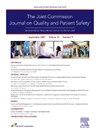Patient Safety Culture Among Nurses in Hospital Settings Worldwide: A Systematic Review and Meta-Analysis
IF 2.4
Q2 HEALTH CARE SCIENCES & SERVICES
Joint Commission journal on quality and patient safety
Pub Date : 2025-01-20
DOI:10.1016/j.jcjq.2025.01.007
引用次数: 0
Abstract
Background
Assessment of patient safety culture (PSC) is critical for health care organizations worldwide to recognize areas that require urgent attention, promote patient safety, and improve quality of care. The aim of this systematic review was to determine the overall PSC score among nurses worldwide and identify the dimensions of PSC that score the highest and the lowest, as well as any geographical differentiations.
Methods
Literature research was conducted in PubMed and Scopus search engines and the Agency for Healthcare Research and Quality (AHRQ) Research Reference List to identify studies published in English between January 2004 and May 2023 that used the Hospital Survey on Patient Safety Culture, version 1, to measure hospital nurses’ assessment of PSC. This review followed the PRISMA 2020 guidelines and was registered in PROSPERO.
Results
From 1,507 records, 21 studies were included with 10,951 participants. The overall PSC score was 3.341 (95% confidence interval [CI] 3.221–3.460). The dimension scored highest was Teamwork Within Units, with a mean score of 3.719 (95% CI 3.594–3.844). Staffing, with a mean score of 3.096 (95% CI 2.980–3.212) was scored lowest. Statistically significant differences related to geographical distribution were found for overall PSC score and five of the PSC dimensions.
Conclusion
Nurses throughout the world rated the PSC at their organizations moderate to good. Certain dimensions of PSC were reported to need reinforcement to create a strong overall safety culture in health care. Participants rated European hospitals as having a stronger PSC than South American or Middle Eastern hospitals. Differentiations need to be further studied and analyzed for effective and targeted global interventions.
全球医院护士的患者安全文化:系统回顾与元分析。
背景:患者安全文化评估(PSC)对于世界各地的卫生保健组织识别需要紧急关注的领域、促进患者安全和提高护理质量至关重要。本系统回顾的目的是确定全球护士的PSC总体得分,并确定PSC得分最高和最低的维度,以及任何地理差异。方法:在PubMed、Scopus搜索引擎和AHRQ研究参考文献列表中进行文献研究,找出2004年1月至2023年5月间发表的使用《医院患者安全文化调查》第1版测量医院护士对PSC评估的英文研究。本次审查遵循PRISMA 2020指南,并在PROSPERO注册。结果:从1507份记录中,21项研究纳入了10951名参与者。PSC总分为3.341分(95%可信区间[CI] 3.221-3.460)。得分最高的维度是单位内团队合作,平均得分为3.719 (95% CI 3.594-3.844)。人员配备的平均得分为3.096 (95% CI 2.980-3.212),得分最低。在总体PSC得分和PSC的五个维度上发现了与地理分布相关的统计学显著差异。结论:世界各地的护士对其所在组织的PSC评定为中等至良好。据报告,需要加强PSC的某些方面,以便在保健领域建立牢固的整体安全文化。参与者认为欧洲医院的PSC比南美或中东医院强。需要进一步研究和分析差异,以便进行有效和有针对性的全球干预。
本文章由计算机程序翻译,如有差异,请以英文原文为准。
求助全文
约1分钟内获得全文
求助全文
来源期刊

Joint Commission journal on quality and patient safety
HEALTH CARE SCIENCES & SERVICES-
CiteScore
3.80
自引率
4.30%
发文量
116
审稿时长
49 days
 求助内容:
求助内容: 应助结果提醒方式:
应助结果提醒方式:


